Blade Design and Aerodynamic Performance Analysis of a 20 MW Wind Turbine for LCoE Reduction
Abstract
1. Introduction
2. The Idea of the Low-Induction Rotor
3. Blade Mass Modeling to Reduce Turbine LCoE
3.1. LCoE of Wind Turbine
3.2. Blade Mass Modeling
4. Results and Discussion
4.1. Considerations for Aerodynamic Rotor Design
4.1.1. Aerodynamic Data of Airfoils
4.1.2. Low-Specific Power Design
4.1.3. Basic Design Parameters for 20 MW Wind Turbine
4.2. Low LCoE Design for 20 MW Wind Turbine Rotor
4.2.1. Validation of Mass Model
4.2.2. Axial Induction Factor for Lowest LCoE
4.2.3. Case Study for Different Rotor Design
5. Conclusions
Author Contributions
Funding
Data Availability Statement
Conflicts of Interest
Nomenclature
| a | Axial induction factor |
| a’ | Tangential induction factor |
| B | Number of blades |
| Ci | Chord length at the ith blade element |
| CP | Power coefficient |
| CT | Thrust coefficient |
| F`n | Normal aerodynamic force at a rotor plane |
| I | Area moment of inertia |
| LCoE | Levelized cost of energy |
| M | Bending moment at radial position r |
| r | Radial position from rotating axis |
| R | Rotor radius |
| t | Thickness of airfoil skin, spar, and web |
| u | Wind speed at rotor plane |
| V0 | Free stream wind speed |
| Vrel | Effective wind speed |
| w | Distance between webs |
| α | Ratio of a blade material cost to the total blade cost of a wind turbine system |
| β | Ratio of a blade cost to the total cost of a wind turbine system |
| γ | Coefficient of airfoil web thickness to airfoil skin thickness |
| λ | Tip speed ratio |
| ρ | Air density |
| σ | Stress |
| σsol | Solidity |
| τ | Airfoil thickness |
| φ | Inflow angle |
References
- Fingersh, L.; Hand, M.; Laxson, A. Wind Turbine Design Cost and Scaling Model; Technical Report; National Renewable Energy Laboratory (NREL): Golden, CO, USA, 2006. [Google Scholar]
- Jonkman, J.; Butterfield, S.; Musial, W.; Scott, G. Definition of a 5-MW Reference Wind Turbine for Offshore System Development; Technical Report; National Renewable Energy Laboratory (NREL): Golden, CO, USA, 2009. [Google Scholar]
- Jonkman, J.M.; Buhl, M.L., Jr. FAST User‘s Guide; Technical Report; National Renewable Energy Laboratory (NREL): Golden, CO, USA, 2005. [Google Scholar]
- Gaertner, E.; Rinker, J.; Sethuraman, L.; Zahle, F.; Anderson, B.; Barter, G.; Abbas, N.; Meng, F.; Bortolotti, P.; Skrzypinski, W.; et al. Definition of the IEA Wind 15-Megawatt Offshore Reference Wind Turbine; Technical Report; National Renewable Energy Laboratory (NREL): Golden, CO, USA, 2020. [Google Scholar]
- Bak, C.; Zahle, F.; Bitsche, R.; Kim, T.S.; Yde, A.; Henriksen, L.C.; Natarajan, A.; Hansen, M. Description of the DTU 10 MW Reference Wind Turbine; DTU Wind Energy Report-I-0092; Technical University of Denmark (DTU): Lyngby, Denmark, 2013. [Google Scholar]
- Larsen, T.J.; Hansen, A.M. How 2 HAWC2, the User’s Manual; Risø DTU National Laboratory: Roskilde, Denmark, 2019. [Google Scholar]
- IEC 61400-1; Wind Energy Generation Systems—Part 1: Design Requirements. IEC: Geneva, Switzerland, 2019.
- Bot, E.T.G.; Ceyhan, O. Blade Optimisation Tool User’s Manual; The Energy Research Centre of the Nethelands (ECN): Petten, The Netherlands, 2009. [Google Scholar]
- Montgomerie Jensen, B.O.G.; Brand, A.J.; Bosschers, J.; van Rooij, R.P.J.O.M. Three-Dimensional Effects in Stall; The Energy Research Centre of the Nethelands (ECN): Petten, The Netherlands, 1997. [Google Scholar]
- Peeringa, J.; Brood, R.; Ceyhan, O.; Engels, W.; de Winkel, G. UpWind 20MW Wind Turbine Pre-Design Blade Design and Control; The Energy Research Centre of the Nethelands (ECN): Petten, The Netherlands, 2011. [Google Scholar]
- Ashuri, T.; Martins, J.R.R.A.; Zaaijer, M.B.; van Kuik, G.A.M.; van Bussel, G.J.W. Aeroservoelastic Design Definition of a 20 MW Common Research and Turbine Model. Wind. Energy 2016, 19, 2071–2087. [Google Scholar] [CrossRef]
- Ananda, G.K.; Bansal, S.; Selig, M.S. Aerodynamic Design of the 13.2 MW SUMR-13i Wind Turbine Rotor. In Proceedings of the 2018 Wind Energy Symposium, Kissimmee, FL, USA, 8–12 January 2018. [Google Scholar] [CrossRef]
- Pao, L.Y.; Zalkind, D.S.; Griffith, D.T.; Chetan, M.; Selig, M.S.; Ananda, G.K.; Bay, C.J.; Stehly, T.; Loth, E. Control co-design of 13 MW Downwind Two-bladed Rotors to Achieve 25% Reduction in Levelized Cost of Energy. Annu. Rev. Control 2021, 51, 331–343. [Google Scholar] [CrossRef]
- Qin, C.; Loth, E.; Zalkind, D.S.; Pao, L.Y.; Yao, S.; Griffith, D.T.; Selig, M.S.; Damiani, R. Downwind Coning Concept Rotor for a 25 MW Offshore Wind Turbine. Renew. Energy 2020, 156, 314–327. [Google Scholar] [CrossRef]
- Yao, S.; Chetan, M.; Griffith, D.T.; Mendoza, A.S.E.; Selig, M.S.; Martin, D.; Kianbakht, S.; Johnson, K.; Loth, E. Aero-structural Design and Optimization of 50 MW Wind Turbine with over 250-m Blades. Wind. Eng. 2021, 46, 273–295. [Google Scholar] [CrossRef]
- Innovative Wind Conversion Systems (10–20 MW) for Offshore Applications; Final Report Summary—INNWIND.EU, 7th Framework Project, CORDIS; Eucopean Commission: Luxembourg, 2018; Available online: https://cordis.europa,eu/project/id/308974/reporting (accessed on 11 December 2018).
- Jensen, P.H.; Chaviaropoulos, T.; Natarajan, A. LCoE Reduction for the Next Generation Offshore Wind Turbine; Outcomes from the INNWIND.EU Project; European Commission: Luxembourg, 2017. [Google Scholar]
- Kesikbaş, O. Investigations of Upscaling Effects for Aerodynamic Design of Large Wind Turbine Rotors by Using Bem Theory and Optimization. Master’s Thesis, Middle East Technical University, Ankara, Turkiye, 2019. [Google Scholar]
- Shafiee, M.; Brennan, F.; Espinosa, I.A. A Parametric Whole Life Cost Model for Offshore Wind Farm. Int. J. Life Cycle Assess. 2016, 21, 961–975. [Google Scholar] [CrossRef]
- Griffith, D.T.; Johanns, W. Large Blade Manufacturing Cost Studies Using the Sandia Blade Manufacturing Cost Tool and Sandia 100-Meter Blades; SANDIA REPORT; Sandia National Laboratories: Albuquerque, NM, USA, 2013. [Google Scholar]
- Ashuri, T. Beyond Classical Upscaling: Integrated Aeroservoelastic Design and Optimization of Large Offshore Wind Turbines. Ph.D. Thesis, Delft University of Technology, Zuid-Holland, The Netherlands, 2012. [Google Scholar]
- Ashuri, T.; Zaaijer, M.B.; Martins, J.R.R.A.; van Bussel, G.J.W.; van Kuik, G.A.M. Multidisciplinary Design Optimization of Offshore Wind Turbines for Minimum Levelized Cost of Energy. Renew. Energy 2014, 68, 893–905. [Google Scholar] [CrossRef]
- Serafeim, G.; Manoas, D.; Riziotis, V.; Chaviaropoulos, P. Multidisciplinary Aeroelastic Optimization of a 10 MW-scale Wind Turbine Rotor Targeting to Reduced LCoE. J. Phys. Conf. Ser. 2022, 2265, 042051. [Google Scholar] [CrossRef]
- Bortolotti, P.; Berry, D.; Murray, R.; Gaertner, E.; Jenne, D.; Damiani, R.; Barter, G.; Dykes, K. A Detailed Wind Turbine Blade Cost Model; Technical Report; National Renewable Energy Laboratory (NREL): Golden, CO, USA, 2019. [Google Scholar]
- Kannan, B.; Jeyyaraj, B. Low Specific Power Wind Turbines for Reduced Levelized Cost of Energy; IntechOpen: London, UK, 2022. [Google Scholar]
- Hansen, M.O.L. Aerodynamics of Wind Turbine, 2nd ed.; EARTHSCAN: London, UK, 2008. [Google Scholar]
- Jang, K.H. 20 MW Class Low-Induction Rotor Shape Design and Analysis for LCoE Reduction. Master’s Thesis, Jeonbuk National University, Jeonju, Republic of Korea, 2023. [Google Scholar]
- Chaviaropoulos, P.K.; Chortis, D.; Lekou, D. Definition of the Reference Wind Turbine—Analysis of Rotor Design Paramete; INNWIND.EU Project, Deliverable 1.2.1; European Commission: Luxembourg, 2013. [Google Scholar]
- Giguère, P.; Selig, M.S.; Tangler, J.L. Blade Design Trade-Offs Using Low-Lift Airfoils for Stall-Regulated HAWTs. J. Sol. Energy Eng. 1999, 121, 217–223. [Google Scholar] [CrossRef]
- Giguère, P.; Selig, M.S. Blade Geometry Optimization for the Design of Wind Turbine rotors. In Proceedings of the 2000 ASME Wind Energy Symposium, AIAA-2000-0045, 2000 ASME Wind Energy Symposium, Reno, NV, USA, 10–13 January 2000. [Google Scholar] [CrossRef]
- Hibbeler, R.C. Mechanics of Materials, 9th ed.; PEARSON: London, UK, 2013. [Google Scholar]
- Ryu, K.W.; Seo, Y.S.; Jeon, H.M.; Cho, H.S.; Park, S.Y.; Jang, K.H.; Choi, J.H.; Song, P.M.; Jung, I.H.; Cheon, S.W.; et al. Conceptual Design for 20 MW Class Offshore Wind Power System around Korean Peninsula; R21XO01-6; Korea Electric Power Corporation: Naju-si, Republic of Korea, 2022. [Google Scholar]
- Ryu, K.W.; Jang, K.H. Aerodynamic Design and Loads Analysis for 20 MW Offshore Wind Turbine System. In Proceedings of the 2022 Spring Conference of Korea Wind Energy Association, Jeju, Republic of Korea, 20–22 June 2022. [Google Scholar]
- Desmond, C.; Murphy, J.; Blonk, L.; Haans, W. Description of an 8 MW Reference Wind Turbine. J. Phys. Conf. Ser. 2016, 753, 92013. [Google Scholar] [CrossRef]
- Schepers, J.G.; Ceyhan, O.; Savenije, F.J.; Stettner, M.; Kooijman, H.J.; Chaviarapoulos, P.; Sieros, G.; Simao Ferreira, C.; Sørensen, N.; Wächter, M.; et al. AVATAR: AdVanced Aerodynamic Tools for Large Rotors. In Proceedings of the 33rd Wind Energy Symposium, Kissimmee, FL, USA, 5–9 January 2015. [Google Scholar] [CrossRef]
- Oh, K.Y.; Kim, J.Y.; Lee, J.S.; Ryu, K.W. Wind resource assessment around Korean Peninsula for feasibility study on 100 MW offshore wind farm. Renew. Energy 2012, 42, 217–226. [Google Scholar] [CrossRef]
- Selig, M.S. PROPID User Manual; University of Illinois at Urbana-Champaign: Champaign, IL, USA, 2012. [Google Scholar]
- Jang, K.H.; Ryu, K.W. Blade Shape Design with Minimization of LCoE. In Proceedings of the 2022 Spring Conference of Korea Wind Energy Association, Jeju, Republic of Korea, 20–22 June 2022. [Google Scholar]
- Bortolotti, P.; Tarrés, H.C.; Dykes, K.; Merz, K.; Sethuraman, L.; Verelst, D.; Zahle, F. Systems Engineering in Wind Energy WP2.1 Reference Wind Turbines; Technical Report; IEA Wind; National Renewable Energy Laboratory: Oak Ridge, TN, USA, 2019. [Google Scholar]
- Griffith, D.T.; Ashwill, T.D. The Sandia 100-Meter All-Glass Baseline Wind Turbine Blade: SNL 100-00; SANSDIA REPORT; Sandia National Laboratories: Albuquerque, NM, USA, 2011. [Google Scholar]
- Chaviaropoulos, P.; Sieros, G. Design of low induction rotors for use in large offshore wind farms. In Proceedings of the Scientific Track, European Wind Energy Association (EWEA), Barcelona, Spain, 10–13 March 2014. [Google Scholar]
- Bergami, L.; Madsen, H.A.; Rasmussen, F. A two-bladed teetering hub configuration for the DTU 10 MW RWT: Loads considerations. In Proceedings of the EWEA 2014, Barcelona, Spain, 10–13 March 2014. [Google Scholar]
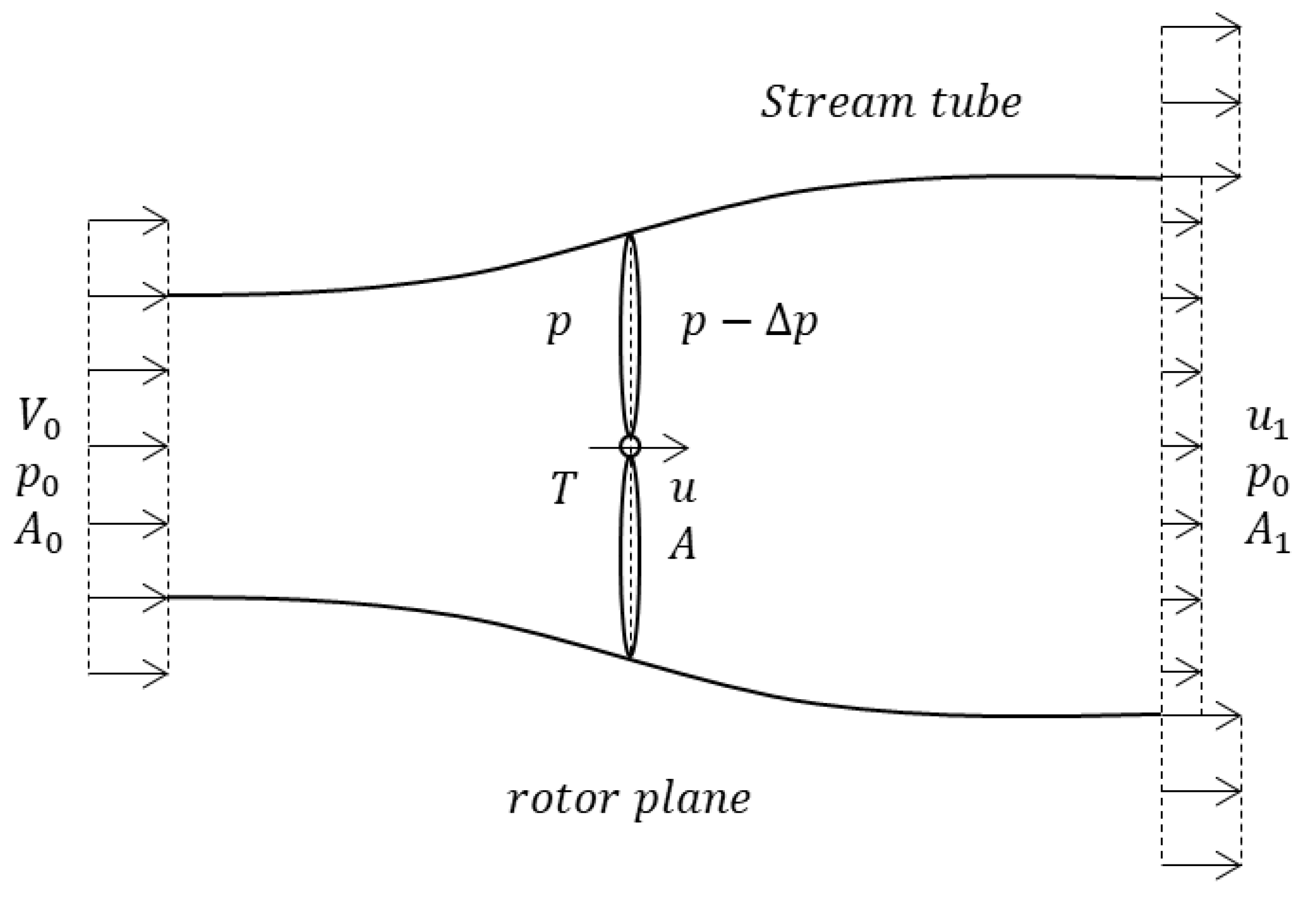
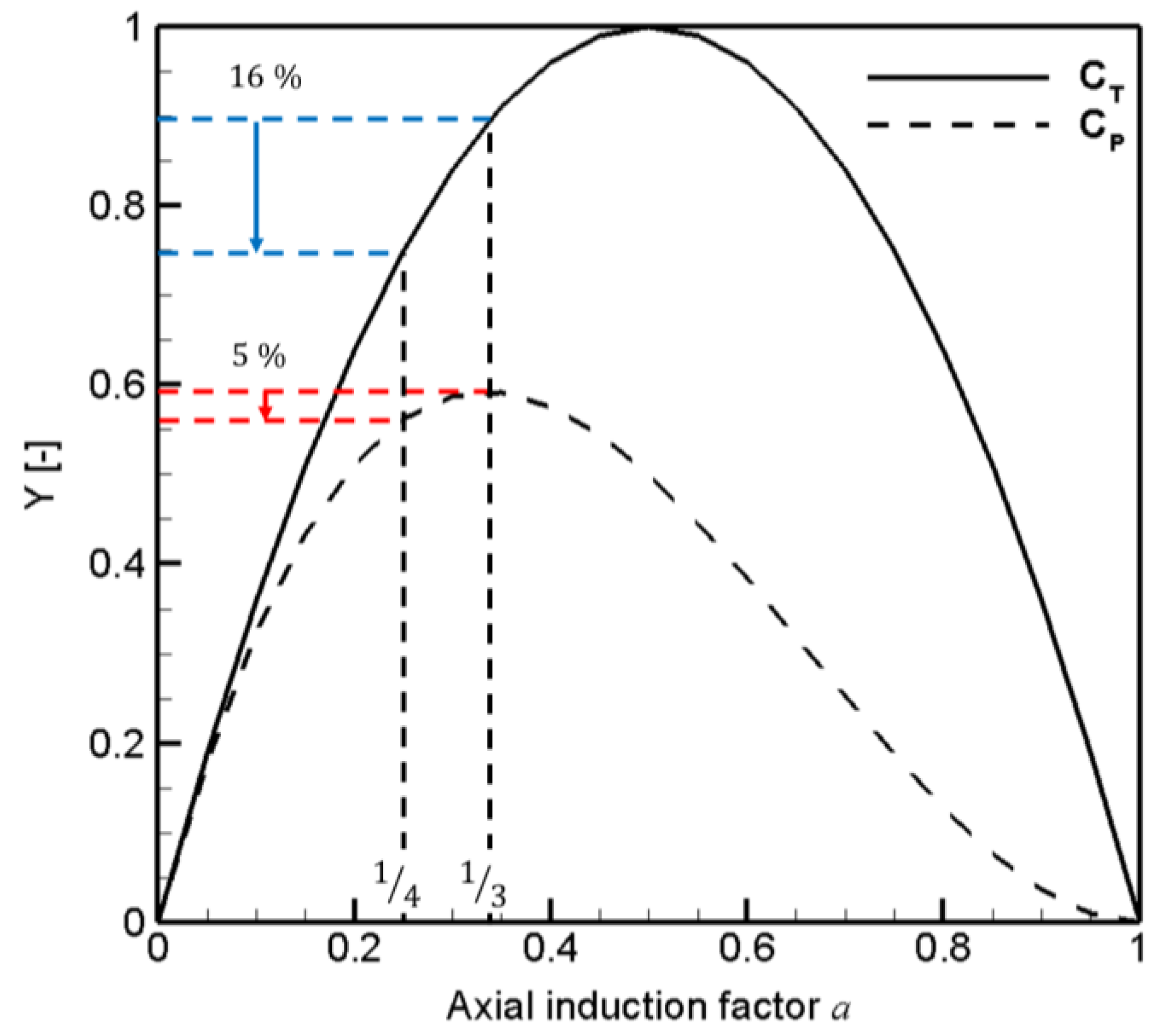
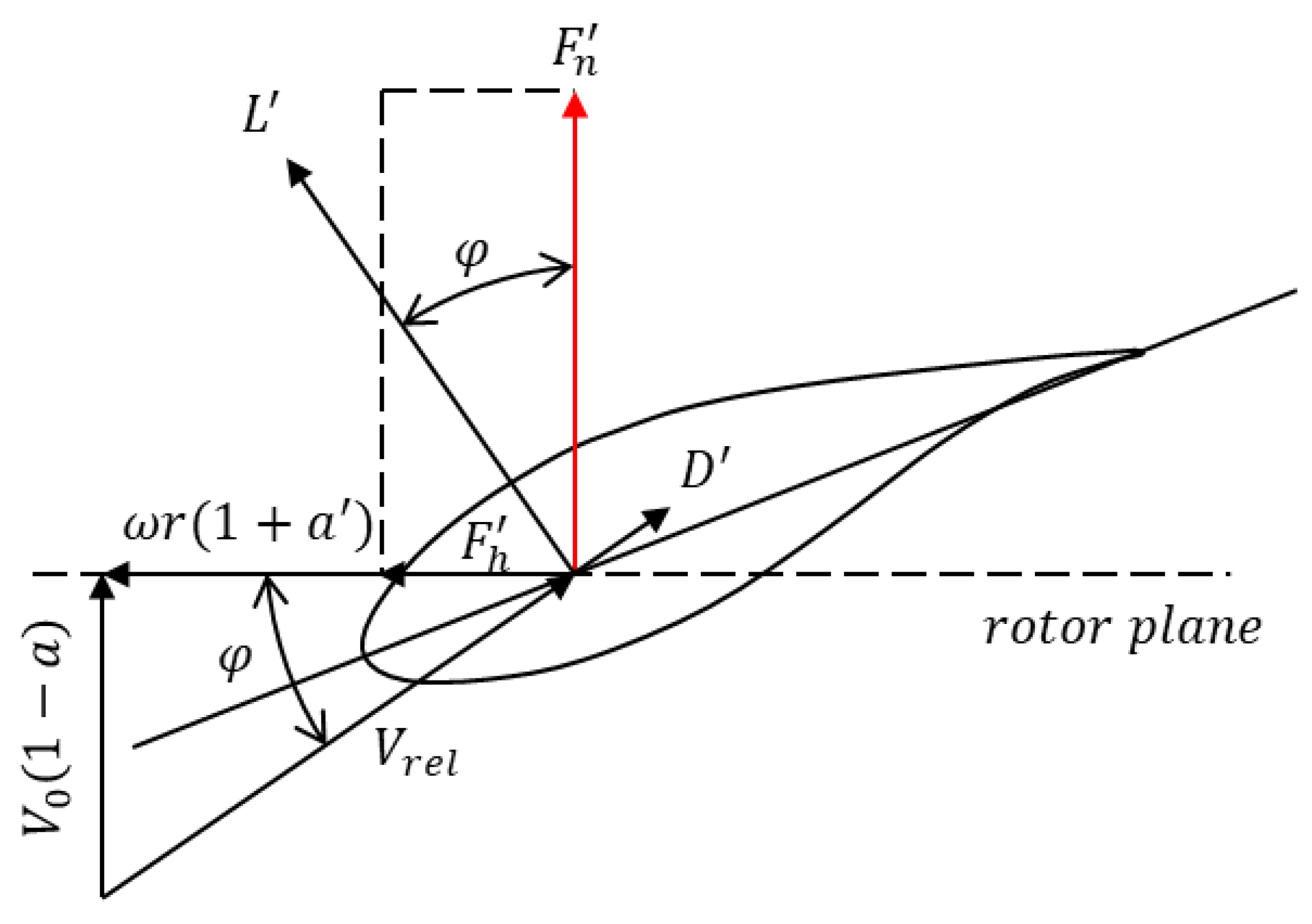
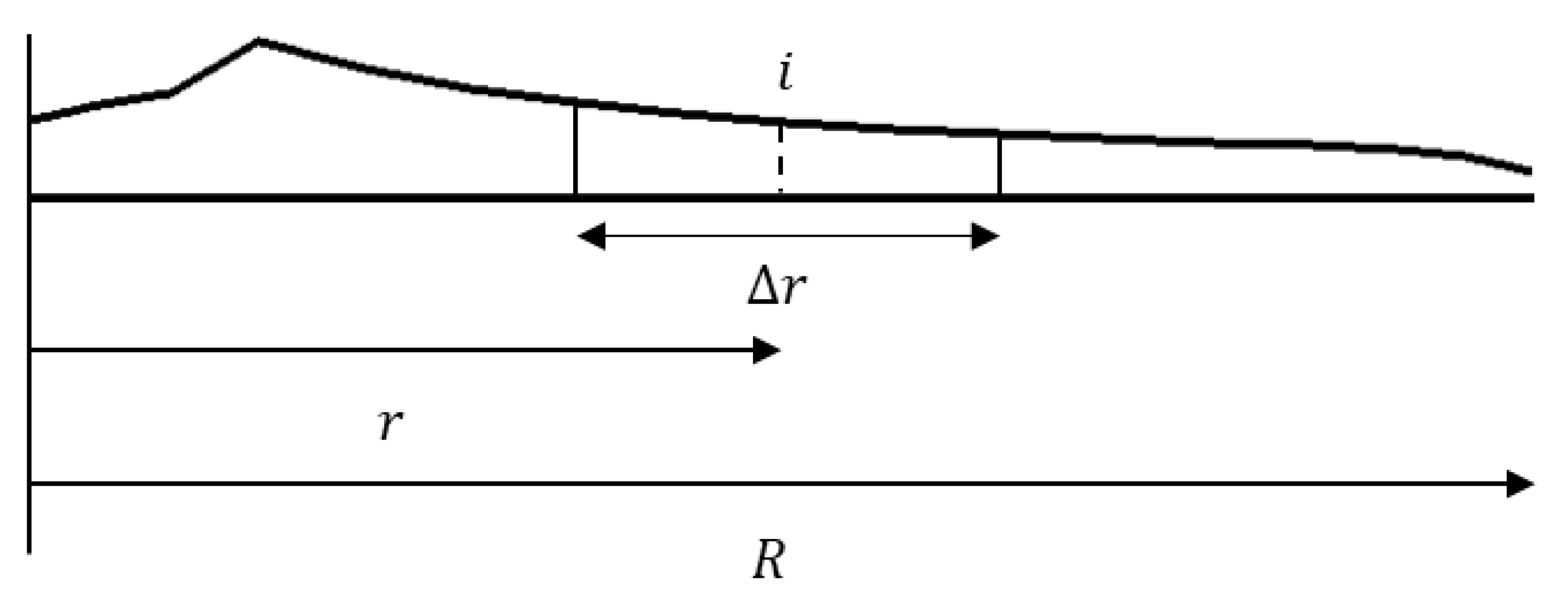
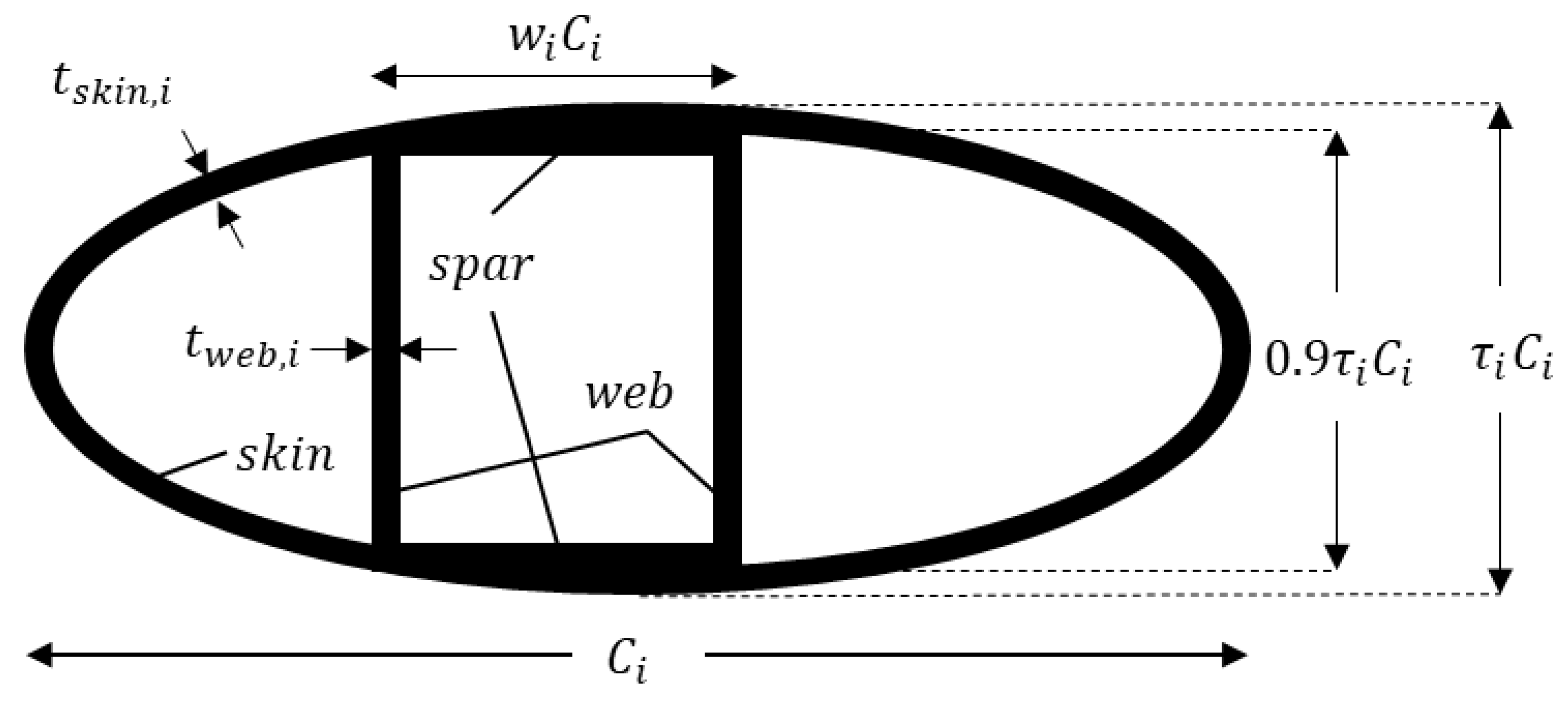
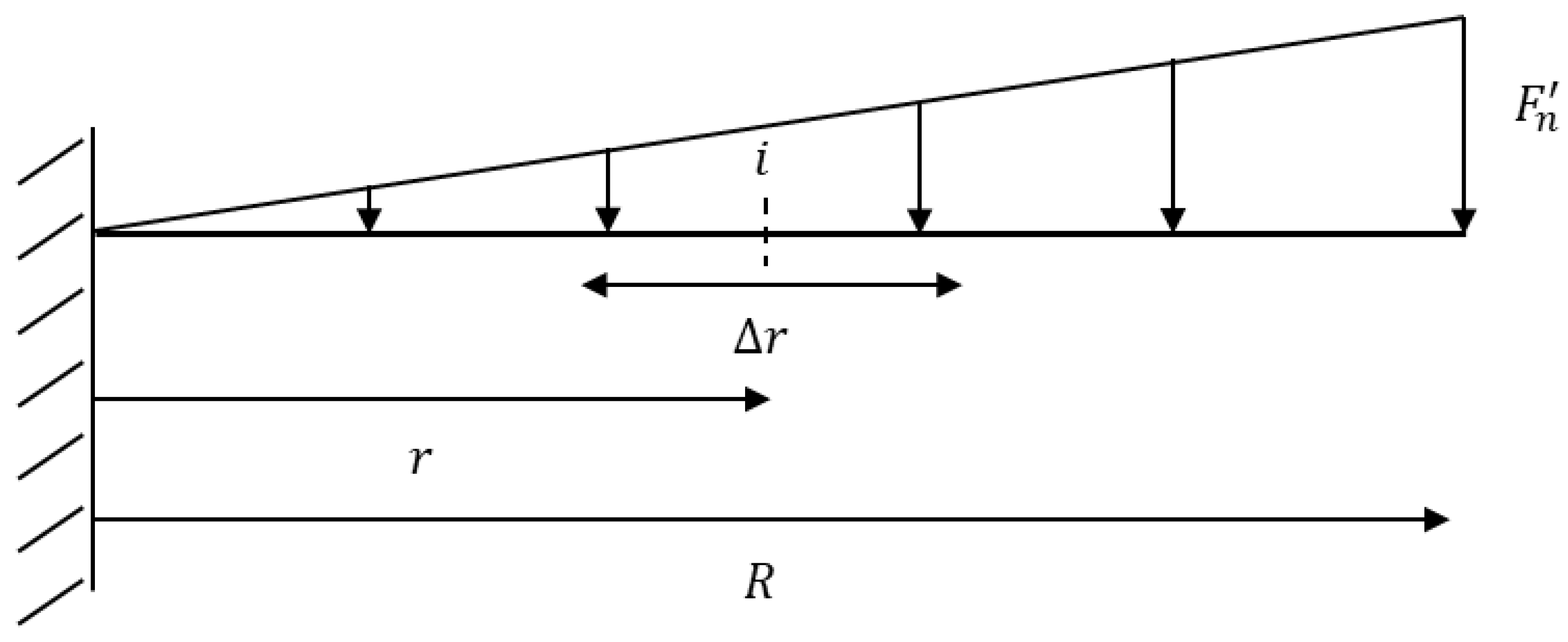
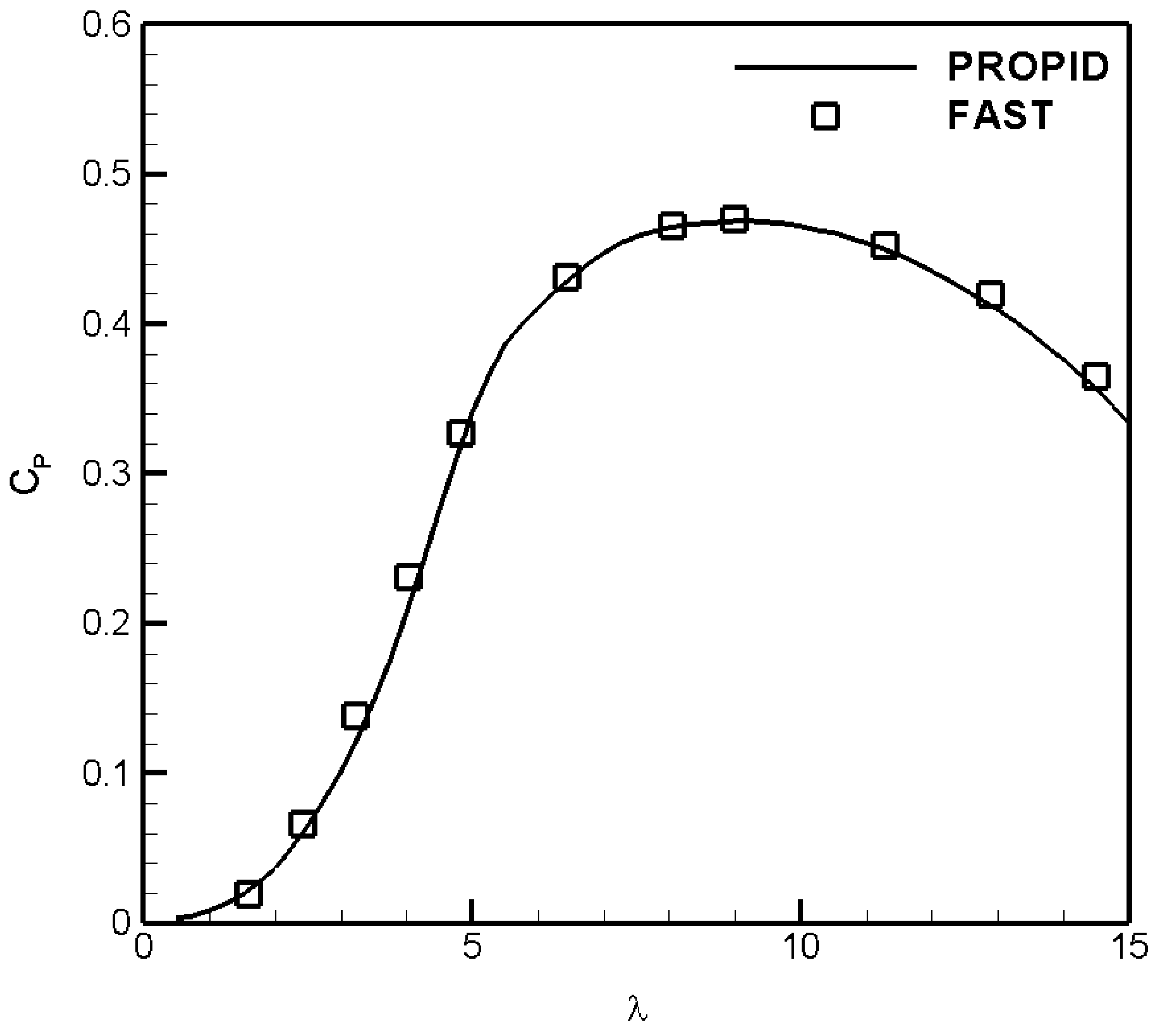
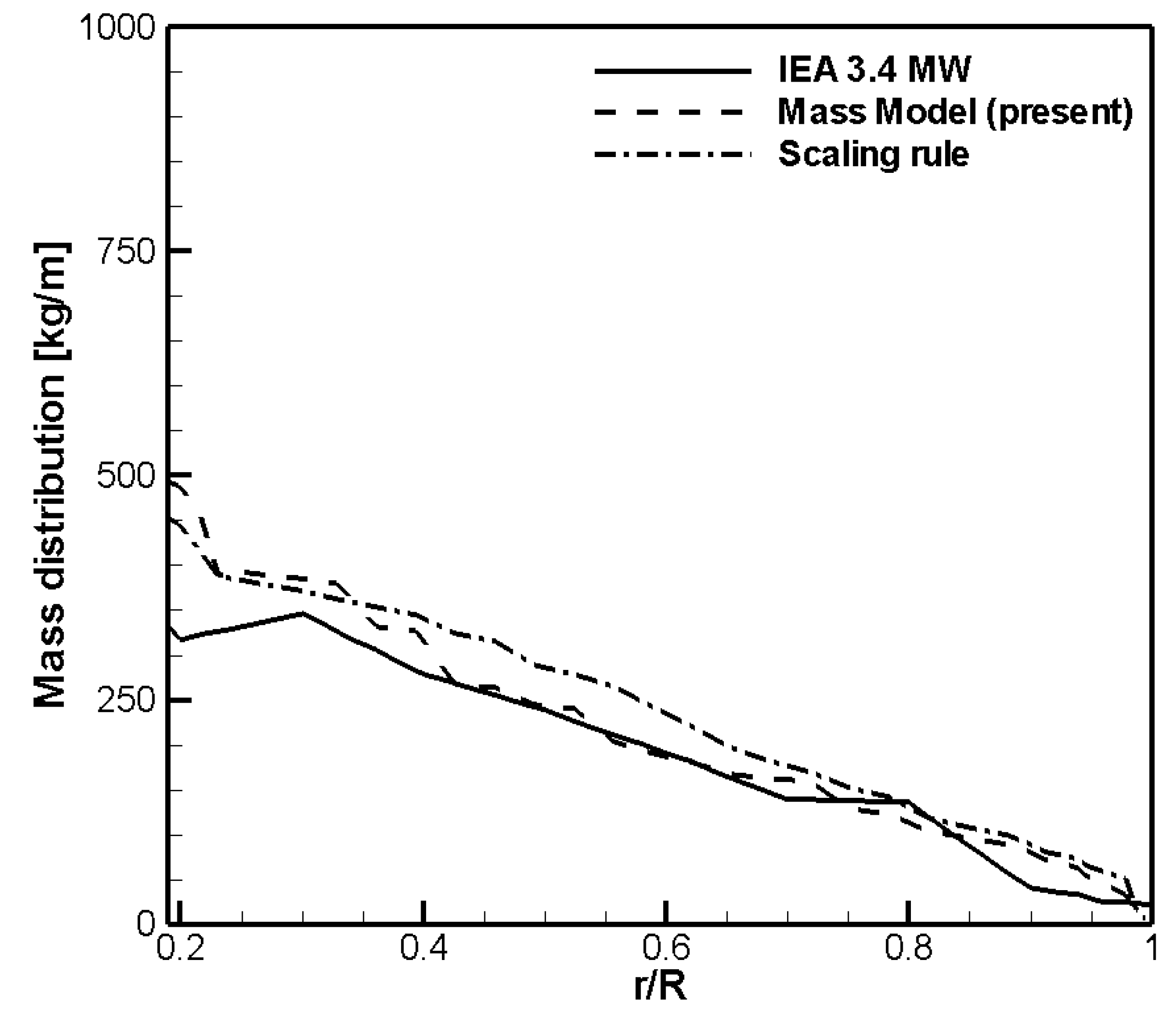

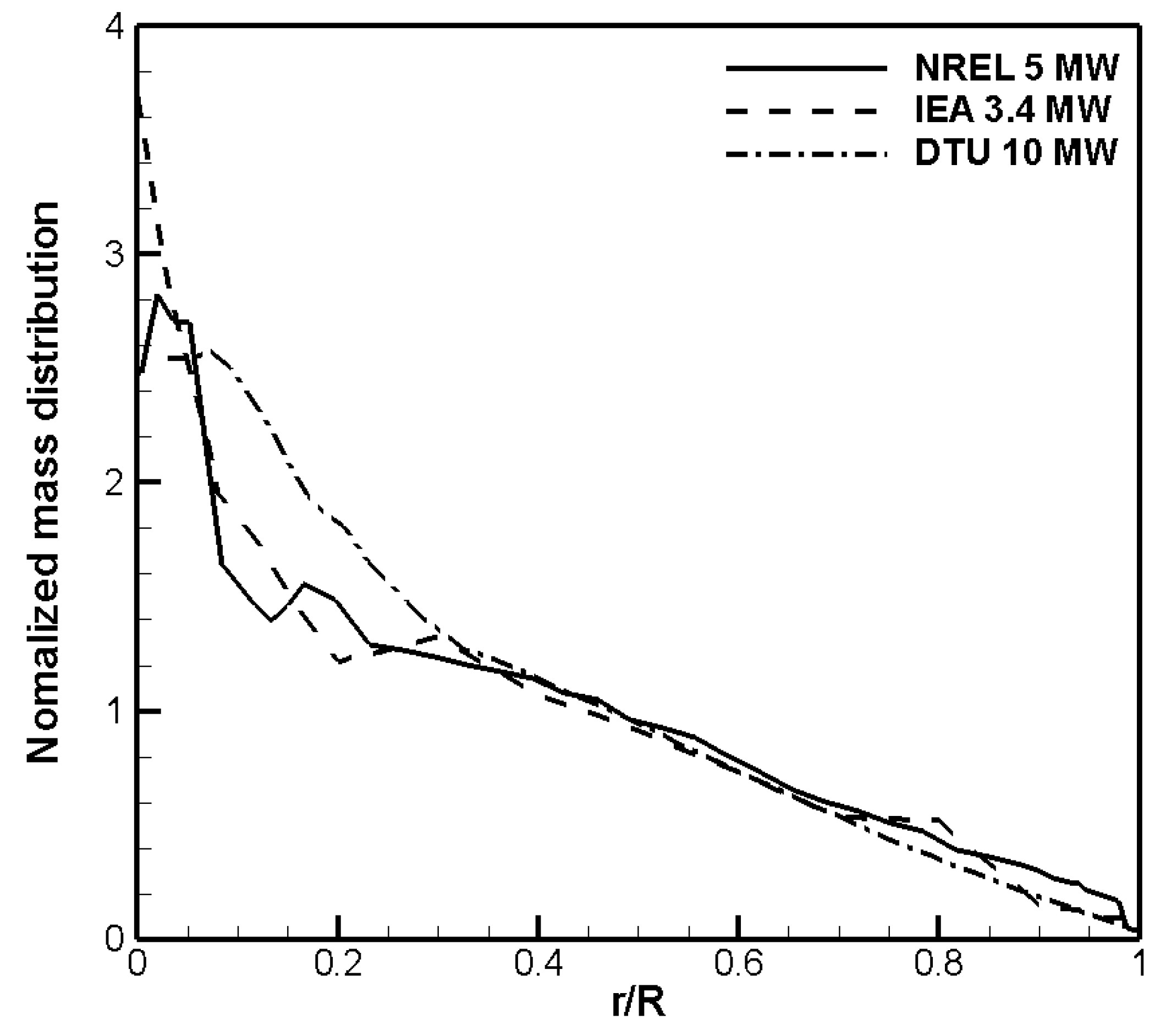

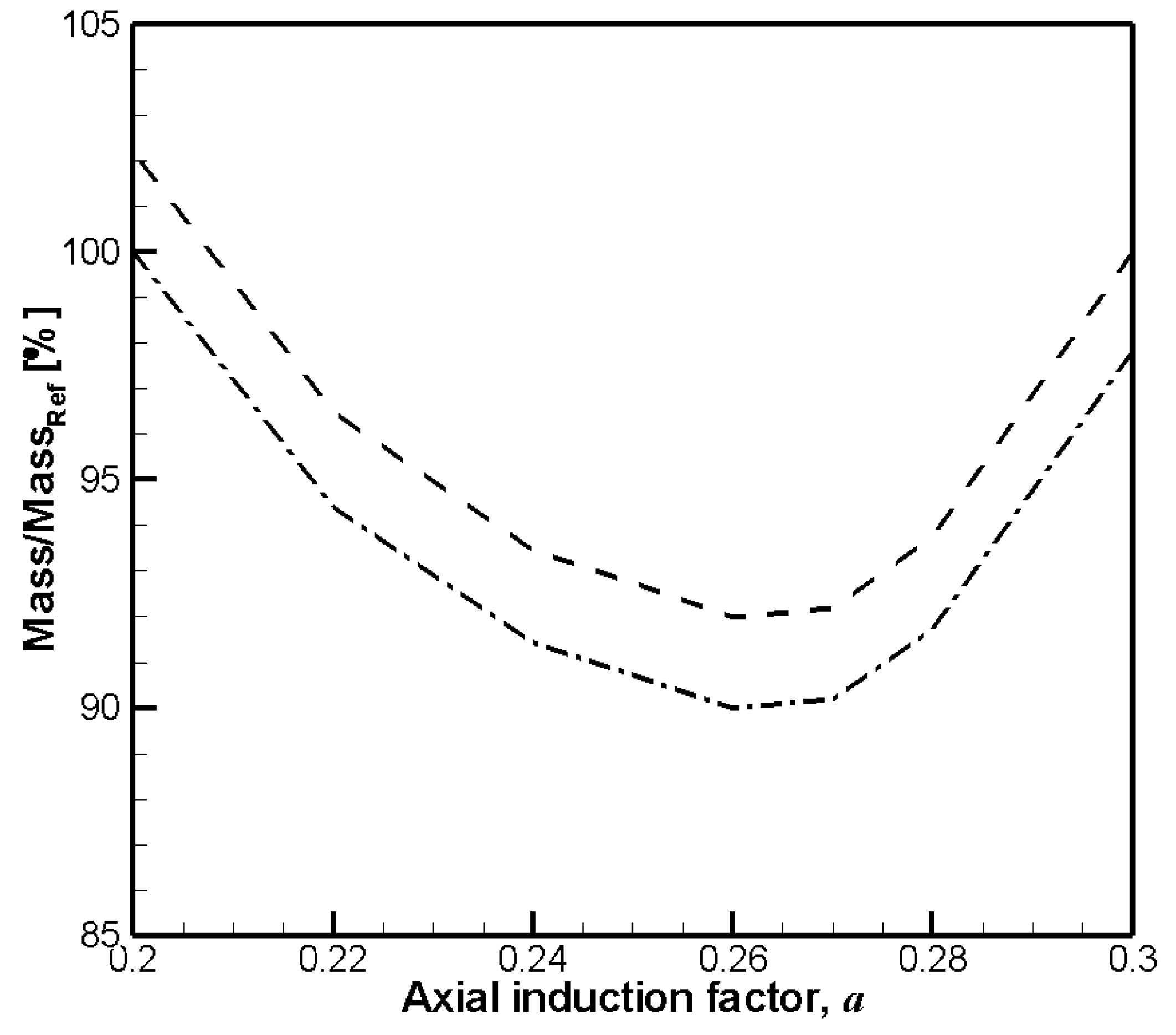
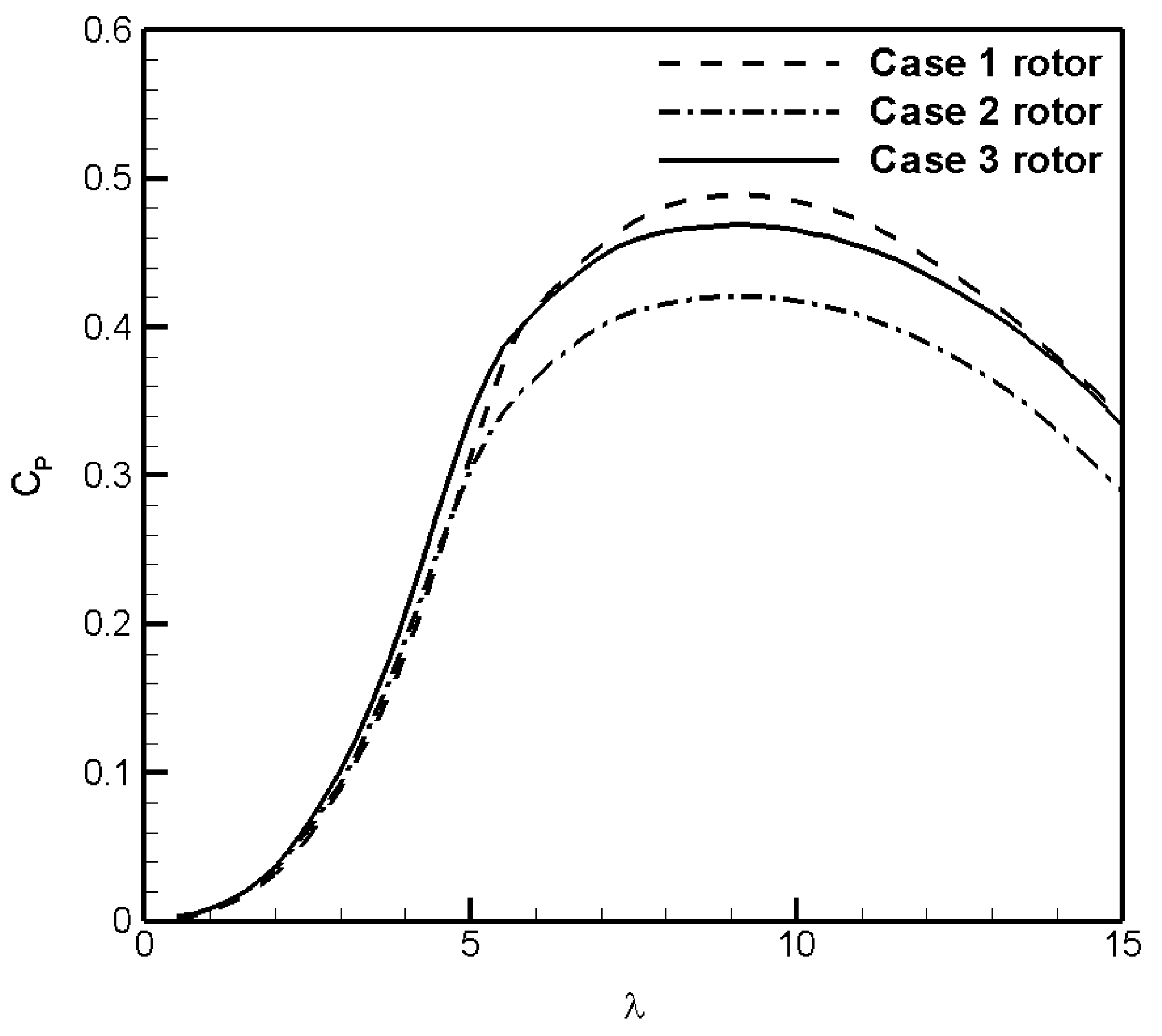
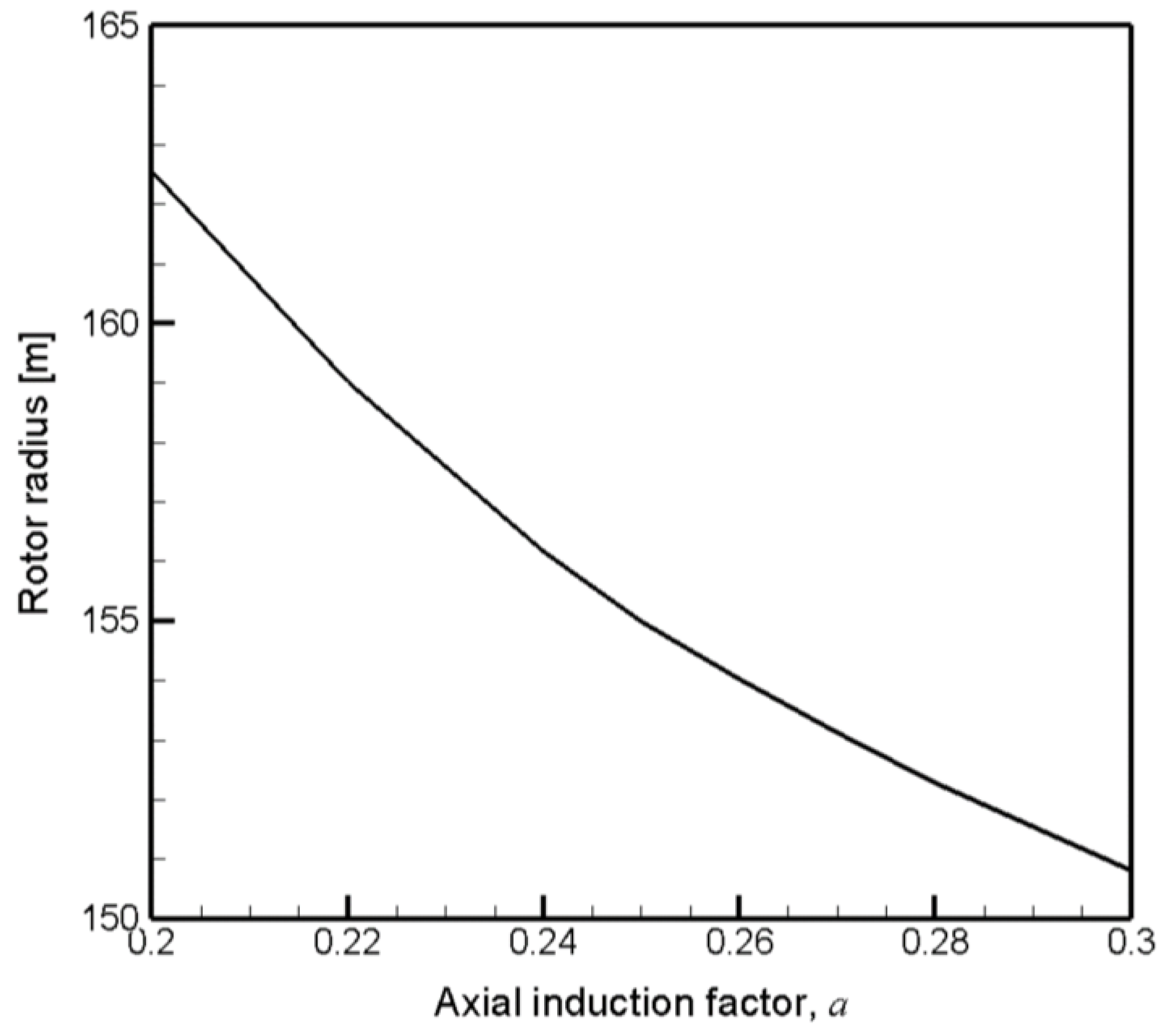
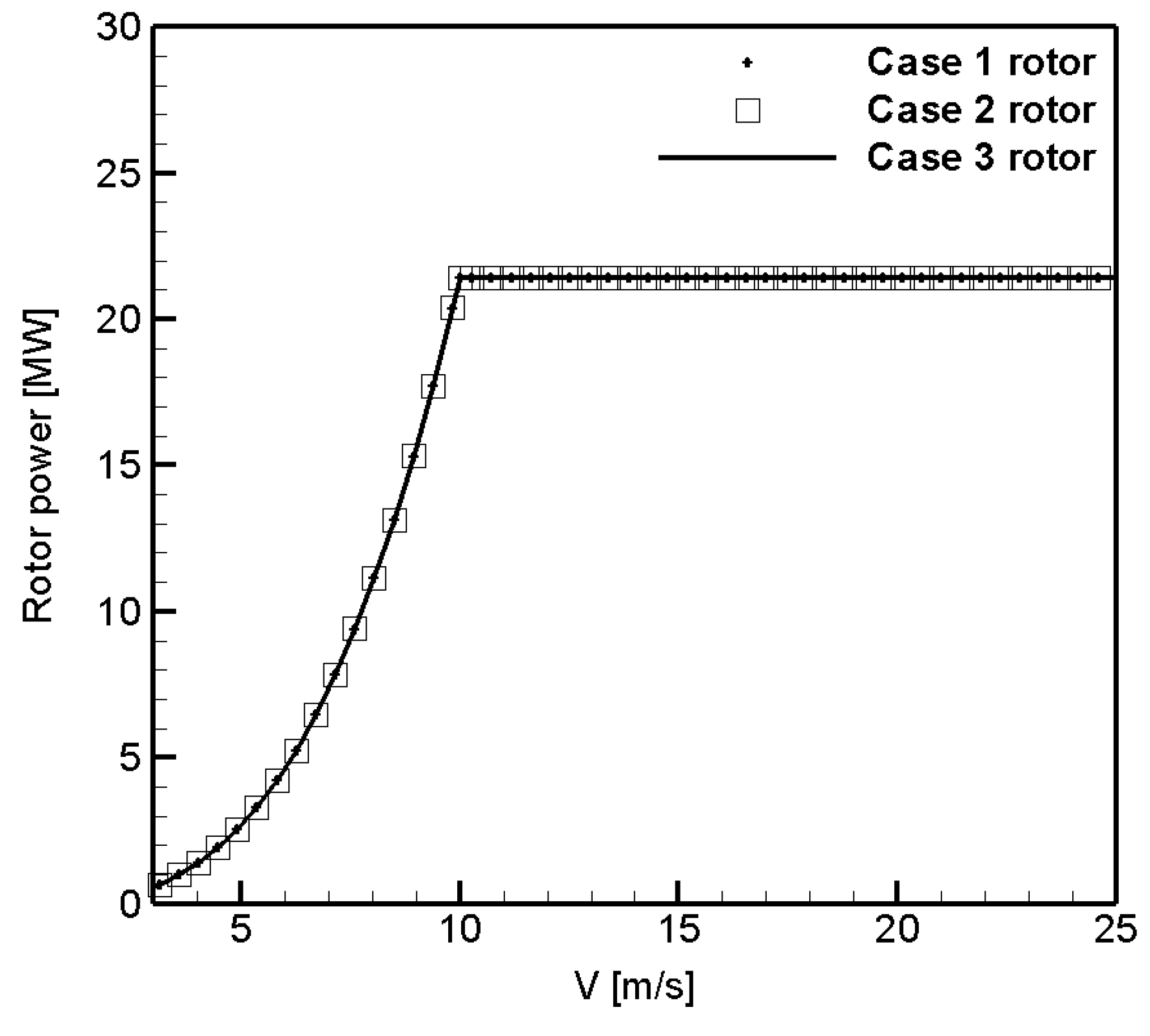


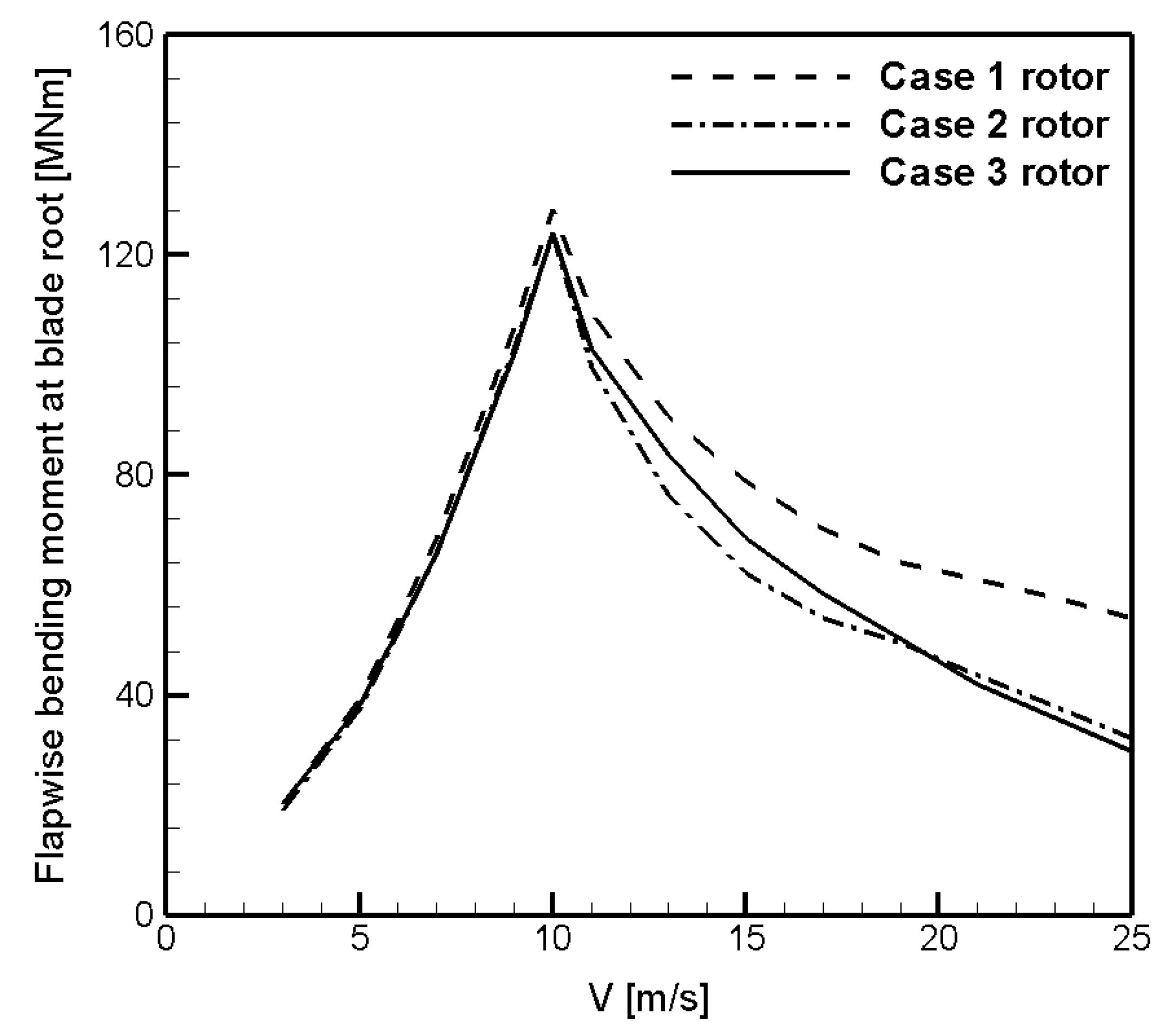
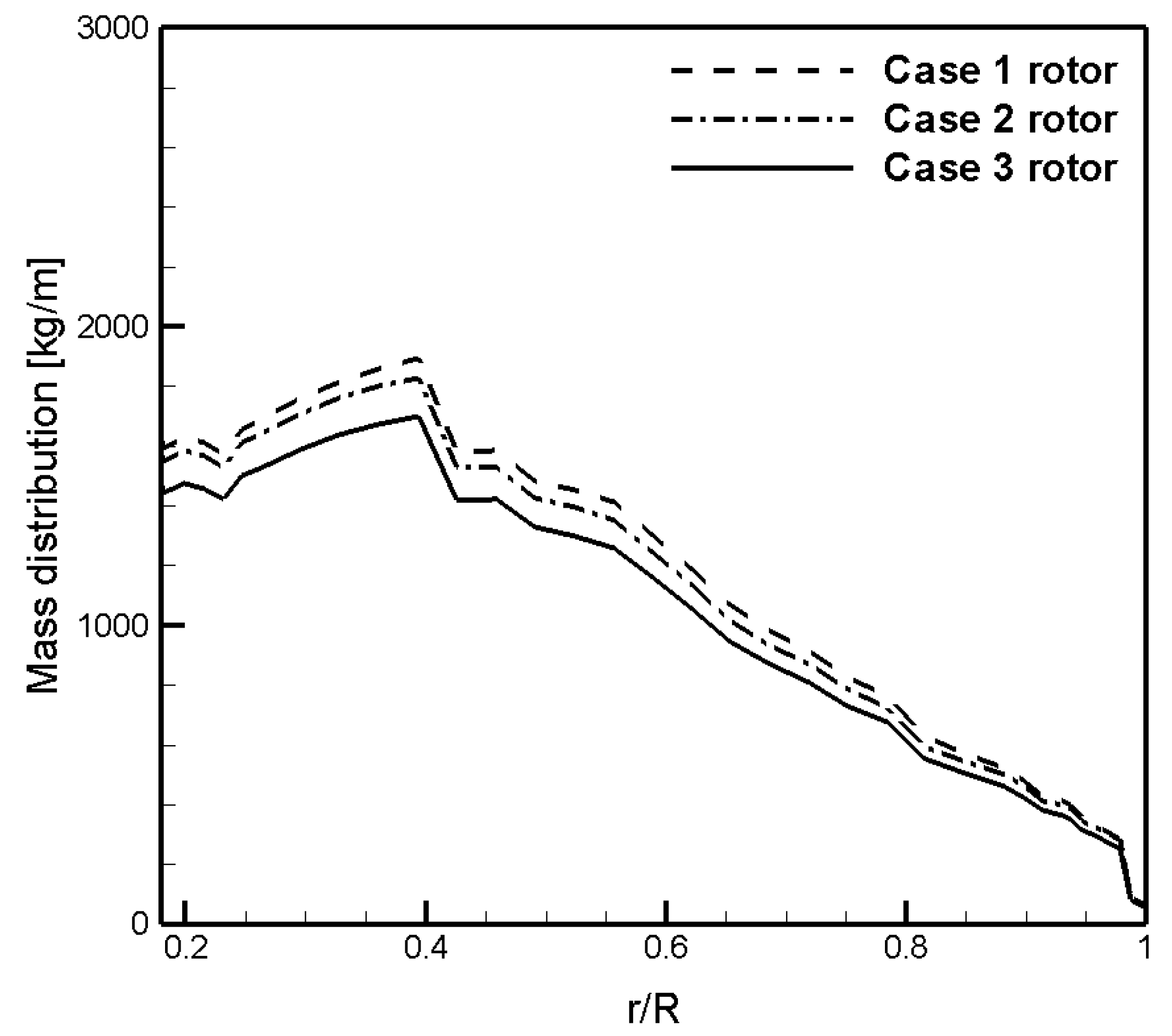

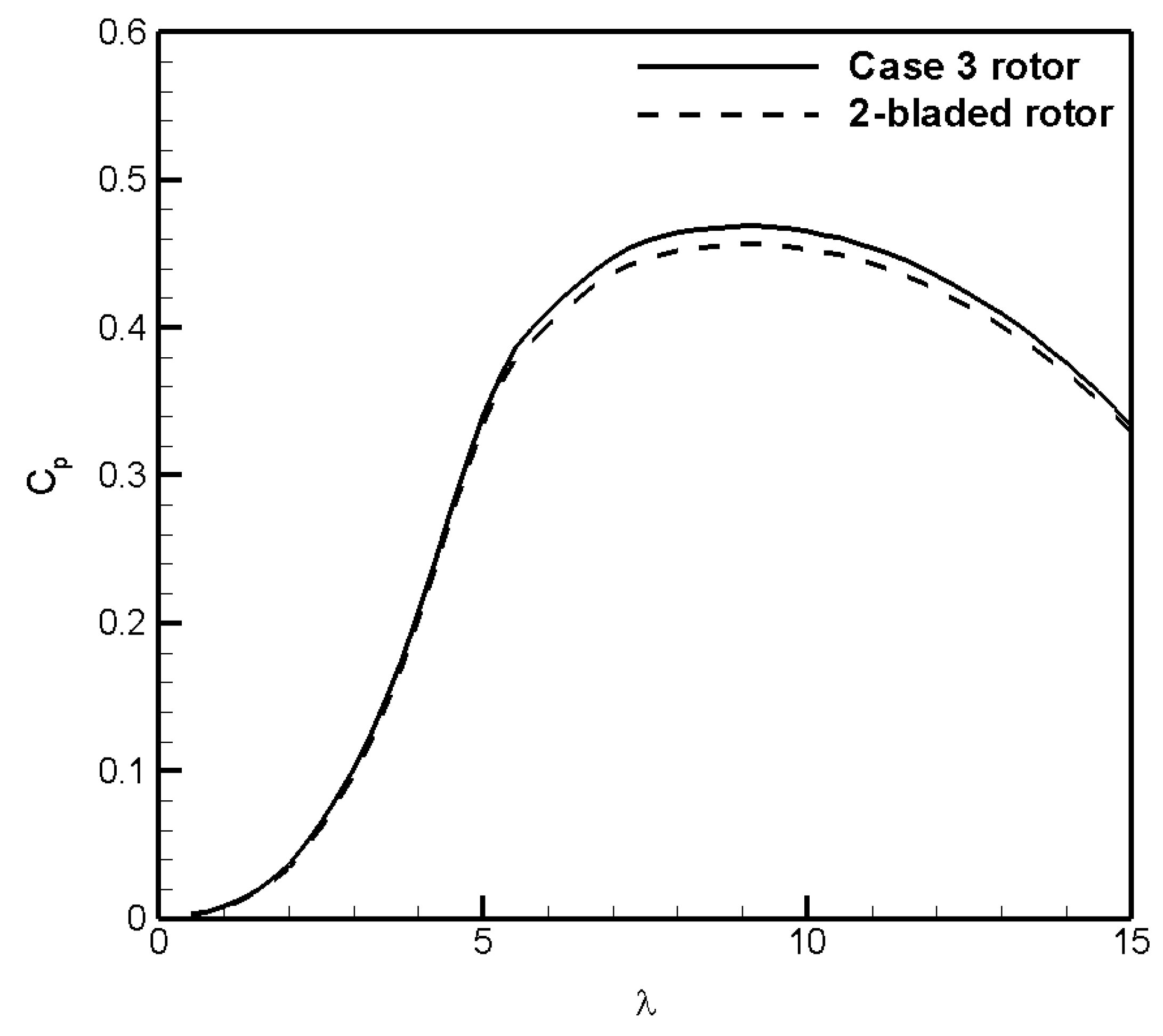
| Turbine/Project | Rated Power [MW] | Material [%] | Labor [%] | Etc. [%] |
|---|---|---|---|---|
| WindPACT [24] | 1.5 | 47 | 26 | 27 |
| IEA 3.4 MW [24] | 3.4 | 48 | 25 | 27 |
| SNL 100-00 [20] | 13.2 | 72 | 14 | 14 |
| SNL 100-01 [20] | 13.2 | 75 | 12 | 13 |
| SNL 100-03 [24] | 13.2 | 60 | 16 | 24 |
| Turbine/Project | Rated Power [MW] | Blades [%] | ICC [%] | O&M [%] | Etc [%] |
|---|---|---|---|---|---|
| Baseline of [1] | 3 | 3.6 | 72.9 | 20.6 | 6.5 |
| Ashur et al. [11] | 20 | 28.4 | 87.9 | 3.9 | 8.4 |
| Ashuri [21] | 10 | 5.8 | 70.0 | 26.1 | 3.9 |
| Ashuri [21] | 20 | 8.2 | 73.5 | 23.2 | 3.3 |
| INNWIND.EU [28] | 10 | 3.73 | 62.5 | 37.5 | - |
| INNWIND.EU [28] | 10 | 3.78 | 61.6 | 38.4 | - |
| r/R | Airfoil | Thickness Ratio | Relative Error [%] | ||
|---|---|---|---|---|---|
| 0.046 | Cylinder | 1.00 | 6.28 | 6.28 | 0 |
| 0.089 | Cylinder | 1.00 | 6.28 | 6.28 | 0 |
| 0.132 | Cylinder | 1.00 | 6.28 | 6.28 | 0 |
| 0.187 | DU99_W_405LM | 0.40 | 2.28 | 2.39 | 4.8 |
| 0.252 | DU99_350 | 0.35 | 2.22 | 2.35 | 5.9 |
| 0.317 | DU99_350 | 0.35 | 2.22 | 2.35 | 5.9 |
| 0.382 | DU97_W_300 | 0.30 | 2.16 | 2.32 | 7.4 |
| 0.447 | DU97_W_300 | 0.30 | 2.16 | 2.32 | 7.4 |
| 0.512 | DU97_W_300 | 0.30 | 2.16 | 2.32 | 7.4 |
| 0.577 | DU91_W2_250 | 0.25 | 2.12 | 2.29 | 8.0 |
| 0.642 | DU91_W2_250 | 0.25 | 2.12 | 2.29 | 8.0 |
| 0.707 | DU91_W2_250 | 0.25 | 2.12 | 2.29 | 8.0 |
| 0.772 | DU93_W_210LM | 0.21 | 2.09 | 2.27 | 8.6 |
| 0.837 | DU93_W_210LM | 0.21 | 2.09 | 2.27 | 8.6 |
| 0.892 | DU93_W_210LM | 0.21 | 2.09 | 2.27 | 8.6 |
| 0.935 | DU93_W_210LM | 0.21 | 2.09 | 2.27 | 8.6 |
| 0.978 | DU93_W_210LM | 0.21 | 2.09 | 2.27 | 8.6 |
| Turbine/Project | Rated Power [MW] | Rated Wind Speed [m/s] | Rotor Diameter [m] | Specific Power [W/m2] |
|---|---|---|---|---|
| NREL 5 MW [2] | 5 | 11.4 | 126 | 401 |
| DTU 10 MW [5] | 10 | 11.4 | 178.3 | 401 |
| IEA 15 MW [4] | 15 | 10.59 | 240 | 332 |
| ECN 20 MW [10] | 20 | 10.0 | 252 | 401 |
| INNWIND.EU 20 MW [17] | 20 | 11.4 | 252 | 401 |
| LEANWIND [34] | 8 | 12.5 | 164 | 379 |
| AVATAR [35] | 10 | 10.4 | 205.8 | 300 |
| GE 12 MW | 12 | 220 | 316 | |
| Unison 10 MW | 10 | 12.0 | 209 | 292 |
| Doosan 8 MW | 8 | 10.5 | 205 | 242 |
| Descriptions | Values |
|---|---|
| Rated power [MW] | 20 |
| Number of blades | 3 |
| Blade length [m] | 150.81~162.55 |
| Rated wind speed [m/s] | 10 |
| Tip speed ratio [-] | 9 |
| Rated rotational speed [rpm] | 5.54~5.7 |
| Cp,max [-] | 0.421~0.489 |
| Axial induction factor | 0.2~0.3 |
| Turbine | MDAO | Rated Power [MW] | Blade Radius [m] | Blade Mass [kg] | Predicted Mass [kg] |
|---|---|---|---|---|---|
| NREL 5 MW [2] | X | 5 | 63 | 17,740 | 17,740 |
| IEA 15 MW [4] | O | 15 | 120 | 65,250 | 189,169 |
| DTU 10 MW [5] | O | 10 | 89.15 | 41,722 | 47,172 |
| ECN 20 MW [10] | X | 20 | 123 | 161,000 | 135,383 |
| Ashuri 20 MW [11] | O | 20 | 135 | 259,000 | 215,072 |
| SNL 100-03 [13] | X | 13.2 | 100 | 49,519 | 101,232 |
| IEA 3.4 MW [39] | O | 3.4 | 65 | 16,441 | 22,147 |
| SNL 100-00 [40] | X | 13.2 | 102.5 | 114,172 | 80,581 |
| Descriptions | Case 1 Rotor | Case 2 Rotor | Case 3 Rotor |
|---|---|---|---|
| Number of blades | 3 | ||
| Blade length [m] | 150.81 | 162.55 | 154.02 |
| Blade length/Blade length_Case 1 [%] | 100 | 107.8 | 102.1 |
| Cut-in wind speed [m/s] | 3 | ||
| Rated wind speed [m/s] | 10 | ||
| Cut-out wind speed [m/s] | 25 | ||
| Tip speed ratio [-] | 9 | ||
| Rated rotational speed [rpm] | 5.7 | 5.29 | 5.58 |
| Cp,max [-] | 0.4888 | 0.4207 | 0.4686 |
| Cp,max/Cp,max_Case 1 [%] | 100 | 86.1 | 95.9 |
| Designed axial induction factor [-] | 0.3 | 0.2 | 0.26 |
| Blade mass/Blade mass_Case 1 [%] | 100 | 102.2 | 92.0 |
| Ashuri 20 MW [11] | Case 1 | Case 2 | Case 3 | |||||
|---|---|---|---|---|---|---|---|---|
| Equipment | Cost [k$] | Mass [ton] | Cost [k$] | Mass [ton] | Cost [k$] | Mass [ton] | Cost [k$] | Mass [ton] |
| Blade | 4051.7 | 259 | 3735.8 | 228.4 | 3831.4 | 234.2 | 3430 | 209.7 |
| Hub | 1456.9 | 252.8 | 1288.4 | 223.6 | 1320.5 | 229.1 | 1185.8 | 205.8 |
| Pitch system | 1945.3 | 236 | 2468.6 | 208.3 | 3005.6 | 213.5 | 2604.3 | 191.4 |
| Hub cone | 34.6 | 4.6 | 38.2 | 5.1 | 41.5 | 5.5 | 39.1 | 5.2 |
| Main shaft | 1605.3 | 159.1 | 2073.6 | 205.6 | 2575 | 255.3 | 2203.7 | 218.5 |
| Shaft bearing | 1013.4 | 42.5 | 1380.2 | 57.8 | 1795.4 | 75.2 | 1486 | 62.3 |
| Gearbox | 4955.5 | 161.9 | 4981.9 | 4981.9 | 4981.9 | |||
| Drive train brake | 44.4 | 4 | 44.6 | 4 | 44.6 | 4 | 44.6 | 4 |
| Generator | 1592.2 | 59.8 | 1599 | 60 | 1599 | 60 | 1599 | 60 |
| Electronics | 1572.8 | 1572.8 | 1572.8 | 1572.8 | ||||
| Yaw system | 1495 | 176.8 | 1945 | 237.3 | 2429.1 | 304.2 | 2070.3 | 254.5 |
| Nacelle frame | 752.6 | 280.8 | 895.1 | 348.6 | 1036.3 | 403.6 | 932.7 | 363.2 |
| Nacelle railing | 414.2 | 35.1 | 514.1 | 43.6 | 595.1 | 50.4 | 535.6 | 45.4 |
| Nacelle cover | 279.6 | 23.4 | 291.8 | 23.5 | 291.8 | 23.5 | 291.8 | 23.5 |
| Turbine connection | 1235.5 | 1247.2 | 1247.2 | 1247.2 | ||||
| Cooling and hydraulic system | 309 | 1.6 | 310.3 | 1.6 | 310.3 | 1.6 | 310.3 | 1.6 |
| Monitoring and safety system | 65.4 | 65.4 | 65.4 | 65.4 | ||||
| Tower | 3971 | 1588.3 | 3971.0 | 1588.3 | 3971.0 | 1588.3 | 3971.0 | 1588.3 |
| Turbine Capital Costs | 34,897.8 | 35,888.5 | 38,376.6 | |||||
| Foundation | 290.7 | 290.7 | 290.7 | 290.7 | ||||
| Installation | 363.1 | 363.1 | 363.1 | 363.1 | ||||
| Farm connection | 838.2 | 838.2 | 838.2 | 838.2 | ||||
| Site assessment and permit | 934.5 | 934.5 | 934.5 | 934.5 | ||||
| Balance of Station | 2426.5 | 2426.5 | 2426.5 | 2426.5 | ||||
| Initial Capital Cost | 37,324.3 | 38,315 | 40,803.1 | 37,858 | ||||
| Levelized Replacement Cost | 249.3 | 249.3 | 249.3 | 249.3 | ||||
| Maintenance and Operation | 108.7 | 118.1 | 118.1 | 118.1 | ||||
| Interest Rate (FCR) | 0.07 | 0.07 | 0.07 | 0.07 | ||||
| AEP [GWh] | 86 | 93.4 | 93.4 | 93.4 | ||||
| LCoE [$/kWh] | 0.03454 | (0.03051) | 0.03263 | (0.02890) | 0.03450 | (0.03077) | 0.03229 | (0.02856) |
Disclaimer/Publisher’s Note: The statements, opinions and data contained in all publications are solely those of the individual author(s) and contributor(s) and not of MDPI and/or the editor(s). MDPI and/or the editor(s) disclaim responsibility for any injury to people or property resulting from any ideas, methods, instructions or products referred to in the content. |
© 2023 by the authors. Licensee MDPI, Basel, Switzerland. This article is an open access article distributed under the terms and conditions of the Creative Commons Attribution (CC BY) license (https://creativecommons.org/licenses/by/4.0/).
Share and Cite
Jang, K.-H.; Ryu, K.-W. Blade Design and Aerodynamic Performance Analysis of a 20 MW Wind Turbine for LCoE Reduction. Energies 2023, 16, 5169. https://doi.org/10.3390/en16135169
Jang K-H, Ryu K-W. Blade Design and Aerodynamic Performance Analysis of a 20 MW Wind Turbine for LCoE Reduction. Energies. 2023; 16(13):5169. https://doi.org/10.3390/en16135169
Chicago/Turabian StyleJang, Kang-Ho, and Ki-Wahn Ryu. 2023. "Blade Design and Aerodynamic Performance Analysis of a 20 MW Wind Turbine for LCoE Reduction" Energies 16, no. 13: 5169. https://doi.org/10.3390/en16135169
APA StyleJang, K.-H., & Ryu, K.-W. (2023). Blade Design and Aerodynamic Performance Analysis of a 20 MW Wind Turbine for LCoE Reduction. Energies, 16(13), 5169. https://doi.org/10.3390/en16135169





